Brenda Valentine, the “First Lady of Hunting,” from Puryear, Tennessee, is an avid hunter who represents women in the outdoors for the National Wild Turkey Federation (NWTF) and has been a Mossy Oak ProStaff member for years. Brenda bowhunted for deer and in 1986, started shooting tournament archery. She’s been a fulltime professional hunter and outdoors woman since 1996.
One of Brenda Valentine’s Toughest Late Season Mule Deer Hunts
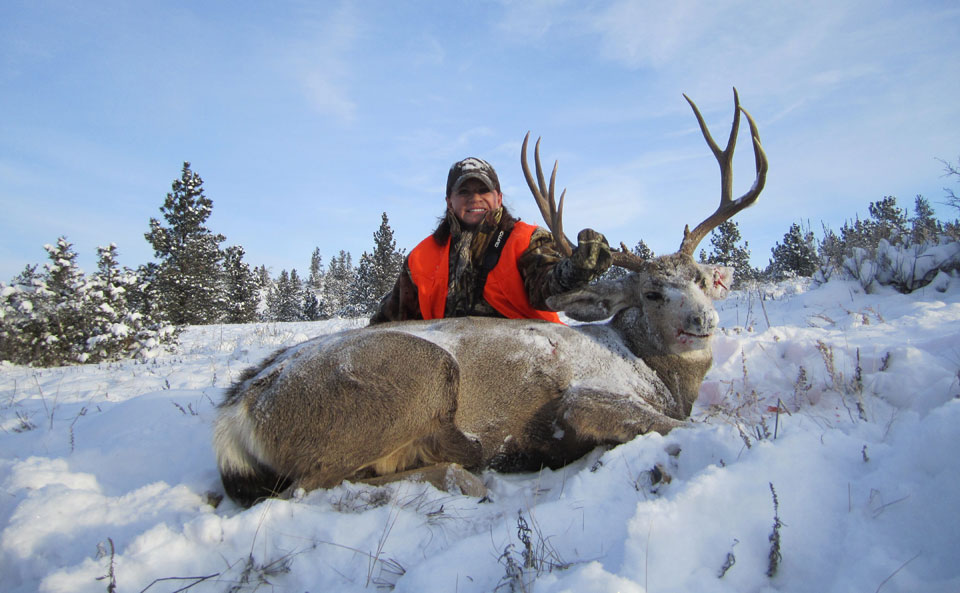
The really difficult aspect of hunting late-season mule deer is just getting around to finding mule deer to hunt. Often they live in mountainous terrain, and during the late season, depending on where you hunt, you may encounter snow up to waist high. Last, but not any less important, is dealing with the wind and the cold. I’ve found that on the mule deer hunts I've taken in the late season, dealing with the wind and the cold are often the toughest parts of the hunt. Since most of my late-season hunting has been when I'm filming TV shows, that cold weather and snow often gives my cameraman and his equipment problems.
One of the toughest late-season mule deer hunts I've ever had was in Montana. We were filming a TV show for Bass Pro Shops, and I had two cameramen with me. The temperature was around zero, and the snow was made up of snow, layers of ice, snow, layers of ice and more snow with layers of ice under it, and you couldn’t see the surface of the road. When I took a step into the snow, the snow would come up over my knees. Even though I had on snow gaiters and a lot of layers of clothing, the weather was still cold and brutal. I started off nearly freezing to death. But when I’d walked 10 or 12 steps, I’d be hot and sweaty.
I had hunted this area before and knew that there was a good population of mule deer there. But if the weather was severe enough, I also realized the mule deer would bed down and hold up under trees. On this hunt, we weren’t using horses, trucks or ATVs, and back then the cameramen had to carry those big, heavy cameras.
Typically, I hunt with my bow or my muzzleloader, but on this hunt, I was hunting with a modern rifle. We’d walk up one hill and down another, trying to spot a mule-deer buck. We’d crawl up on a point and glass for an hour or two. Then we’d move to another point and glass. In that kind of weather, the deer would hold up under an outcropping of rock or under a tree. I guess they had more sense than we did, because they weren’t moving around like they usually would. Then to complicate the hunt even more, as the snow continued to come down, the snow would cover up almost all of the mule deer’s body. Since mule deer have white antlers, trying to see those antlers in the snow was quite difficult. The glare off the snow mixed with the wind almost would blister your eyeballs.
We finally spotted a few bucks, but they were too far away for a shot. Even if I shot, the wind was blowing so hard it could push the bullet around and cause me to miss. We tried to circle around to get close enough to take a shot. But we took half a day to get to where we needed to be to try and take a buck, so we didn’t get on those deer. However, when you're filming a TV show, you have to do everything you can to take a buck, regardless of the weather and the terrain. Maybe a part of being required to find and take a buck in bad weather is pride. But I’ve never liked going home without taking a deer and having a TV show done.
Another problem with hunting late-season mule deer is the mature bucks won’t tolerate a lot of hunting pressure. Mule deer use their eyesight more effectively than whitetails do. So, when they see three hunters, one with a rifle and two with camera gear and tripods, they tend to try and leave the county especially in the late season.
We got on a high point and more or less buried-up in the snow. Finally, we spotted a big mature buck with a few does and couple of smaller bucks walking across the face of a mountain. We thought, if we could move quickly, stay out of sight and get ahead of those deer, I might be able to get a shot. We didn’t have a guide who knew the country. So, we had to more or less figure out where we thought the mule deer would go. We were hoping to outguess the deer as to the direction of travel they were going to take. Luckily, on this hunt, we did guess right. We could see a gap in the ridge, and that’s where we thought they probably would travel. So, we got up to the gap ahead of the herd and took cover in some scrubby pines. We sat there for a while and began to think that we had guessed wrong. But just as we were about to get ready to leave, I looked down the mountain and saw antlers coming through the pines. I could see the mule-deer buck at about 100 yards. I got my rifle on my knee and prepared to make the shot. When I took the shot, the buck went down. As we walked down the mountain, in some places, the snow would be up to my backend. Other places we’d sit down and more or less slide down the hill. When we finally got to the buck, we saw that someone had shot him through the ear earlier, and that hole had healed over.
The good news from this hunt was that we could slide the buck downhill rather than having to drag him down the mountain. Luckily I had two, big, stout guys with me to help me drag the deer. We didn’t go far before we started shedding some of our clothes. Two people would drag, and one person would carry the gun, the clothing we were taking off and part of the camera gear, until we were finally able to get the buck as close to a road as we possibly could. On the ranch that we were hunting, the landowner had big flatbed trucks that were used to carry feed to the cattle. We left the deer and all the gear we had carried at the bottom of the hill. Then we trudged back up the mountain to get the rest of the gear we had left behind. Once we had the deer and all our gear off the mountain, we took the rifle and two cameras and hiked back to where we had left our little rental car. Back then, we didn’t have cell phones. We drove back to the ranch house and told the landowner that we had gotten our buck.
The land we were hunting on belonged to Frank Borman - one of the astronauts who had gone to the moon. His son had invited me and our camera crew to come to the ranch to hunt. One of the ranch hands went with us to help us load up the mule deer and bring him back to the ranch. If you're going to take a late-season mule deer, I've learned that you’ve got to be committed to hunt - regardless of how bad the weather is, and it can really get rough.
Brenda Valentine Finds and Takes Ole Romeo - Her Biggest Mule Deer
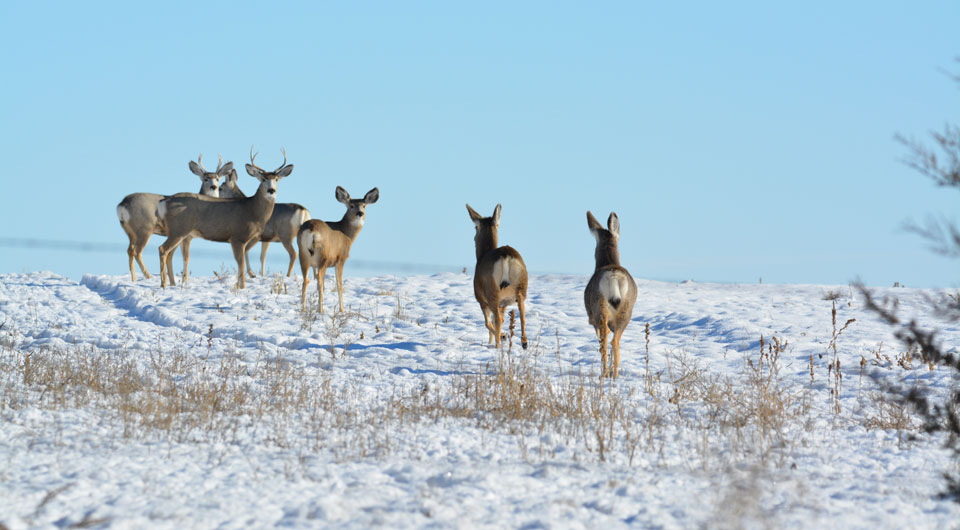
The biggest mule deer I've ever taken weighed about 400 pounds. The cowboys on the ranch had seen this buck for about 7 years. We knew he was a really old buck. I first spotted this buck on day two of the hunt, about 200 yards away. I dropped down to my knees, aimed my Browning .300 WSM rifle and fired downhill at the buck. I had shot this gun for years, and I knew it to be deadly accurate. I was pretty sure I’d hit him, because he hollowed his back and took off over the mountain. I gave my cameramen a thumbs-up and said, “I know I got him.” But when we reached the spot where I had shot the buck, there was no blood. All I found was a small scrap of hair about as big as my thumb. When we replayed the video, the cameraman said, “I think you shot high.”
We hunted for three or four more days and saw plenty of mule deer, but I really wanted to take that buck that I had shot at on the second day of the hunt. Although he didn’t have many points, he had huge bases on his antlers. His body was so big he looked like a horse. One of the last days of the hunt, we spotted this buck again with some does. I got on my knees to take the shot, but the buck stayed right in the middle of the does. I knew there was no way I could shoot the buck without hitting a doe. So, I didn’t take the shot. We decided to wait him out. We had a favorable wind, and we were hidden well enough that the buck didn’t see or smell us. Later the buck separated himself from the does, and I took the shot. When we finally got to the downed buck, I looked at his back, and I saw that the first shot had grazed his back and taken out some hair and just a little bit of the surface of the skin. When I took that first shot, I felt like I had as solid a shot as I'd ever made. However, sometimes when hunting at altitudes, my rifle would shoot a little high. But to be really honest, I never figured out why I missed that buck, and I didn’t have any excuse. Although we had snow on this hunt, the snow wasn’t as deep as it had been a few years earlier
We went back to the ranch house and told the cowboys what we had shot. They decided to use a hay hauler to go back and get the buck. When we got the buck back to the ranch house, all the cowboys came out to look at him. Several said, “We’re so glad that you took Ole Romeo. That ole buck has been around here for years. No one would shoot him, because his antlers didn’t fork on one side, and the other hunters didn’t feel like Ole Romeo was a true trophy. He's been kind of the breeder buck for the entire ranch. We'd all been gunning for this buck this year, because we wanted to take him out of the herd. We saw him on just about every side of the ranch and every time we saw him he'd be with a harem of does. Wherever the girls were - that’s where Ole Romeo would be. He would go from one band of does to another band of does. This is why we nicknamed him Ole Romeo, because he was such a ladies’ man.”
A Muzzleloading Trophy Mule Deer with Brenda Valentine
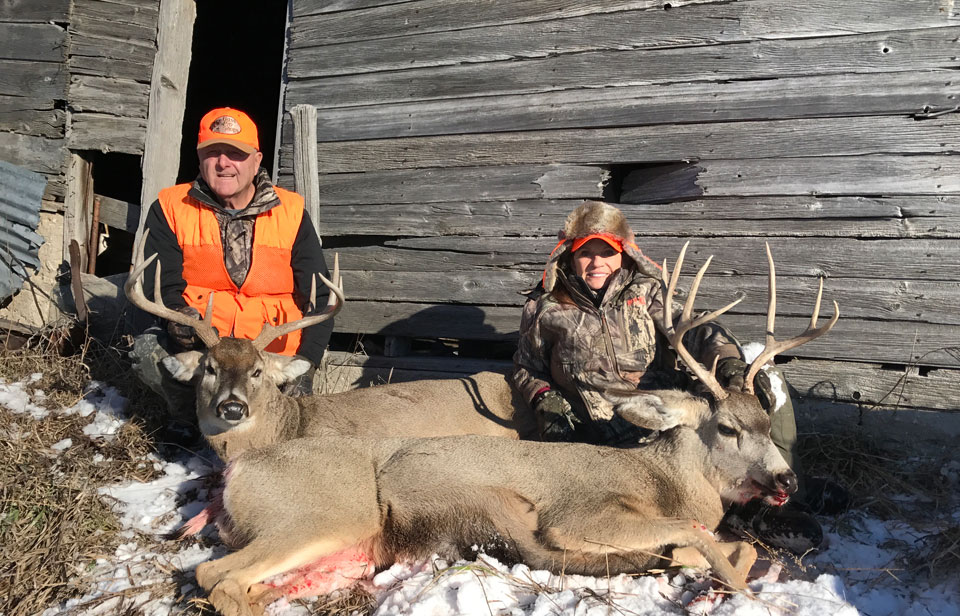
On this hunt on December 12, 2018, I was hunting in Nebraska. A friend had called me and said, “We have a late-season Nebraska muzzleloader hunt, and you can hunt whitetails or mule deer.” So, my husband Barney and I drove out there. The place we were hunting was near the South Dakota border.
There had been about an 8-inch snow before we arrived. So, the snow was crusty and dry, and it was cold and windy. Barney really wanted to take a mule deer. Although he had been around a mule deer, he never was fortunate enough to take a buck. My tag was for a whitetail or mule deer, and I really didn’t care which one I took. We weren’t filming on this hunt. This was just a fun hunt for the two of us, and we only had a couple of days we could hunt. I designated Barney to shoot first, because I felt like we’d get into some really good mule-deer bucks on this hunt. The terrain wasn’t as tough as most places where I'd hunted mule deer, but it had a lot of open country. We were hunting a farm where they combined corn and cut hay for the cattle during the winter. Some of the property was in Conservation Reserve Program (CRP) land where there were a lot of pheasants, and there were quite a few cedar trees used for wind breaks to stop erosion.
We could drive our vehicle up the steep points, get out and glass for deer. Using our binoculars and spotting scopes, we saw quite a few mule deer lying down in places where the farmer had stacked up hay to feed his cattle through the winter. We also spotted quite a few mule deer bedded down in the snow anywhere there was an irregularity in the terrain. Sometimes we’d find them in the tree lines that had been created as wind breaks.
On the second morning of the hunt, Barney went ahead and took a nice white-tailed buck. We had seen a herd of mule deer earlier that morning through our spotting scopes, but they were miles away. The landowner had told us that there were some ridges that you could see for 10 miles from them. After a day or two of hunting, I totally believed he was right.
We went out the next day, and I spotted some does’ heads popping up over some freshly planted cedar trees. These trees were shrub size, and they had been planted in rows to help stop erosion. As I kept watching, I saw a few small bucks standing up in those cedar trees. Finally, I spotted an antler just above those short cedar trees. We had one of the men from the ranch with us. I told him where I was looking, and he put his spotting scope on those short cedars. Then he said, “I see the buck, and he's a shooter.”
I was hunting with a muzzleloader, so we knew we had to get closer for me to be able to make a lethal shot. We used an old field road to close the distance in a truck. Then we got out and started to make a stalk on this buck. We tried to use the terrain to stay out of sight of the buck, but finally we ran out of cover. We came over a hill, and three or four does hopped-up and started looking around themselves. I was hoping that the does would run in the opposite direction of the buck, but they didn’t. They ran right into the herd where the buck and a bunch of does were bedded.
We knew we had two choices. We could stay with this herd and hope to get a shot at the buck or go back to the truck and look for another buck to hunt. We decided to stay with the herd and see what would happen. We stayed low and kept moving to where we had spotted the buck. When we got to the place where we thought we could see his herd, the does that we had spooked had alerted the herd, and all the mule deer were on their feet walking away from us. I saw the buck, and his antlers looked tall. The ranch hand said, “Yonder is your buck.” I quickly dropped down, got my rifle on my knee and decided to take the shot, even though the buck was 250 yards. I knew this was stretching the effective range of my muzzleloader. However, I had shot this gun quite a bit and felt confident that I could down the buck at that distance.
When I squeezed the trigger, I looked through the smoke coming out of the end of the barrel and saw the buck jump like I had hit him. Barney and our ranch hand said, “You hit him.” But then, the buck went over a hill and out of sight.
When he came up on the other hill, Barney said, “No. It looks like you missed him. Yonder he goes. He doesn’t act like he’s hit. He's not limping. He's running at the front of the herd.” I told Barney, “No, I know I hit that buck.”
“He's not lagging back or acting like he’s hurt,” Barney explained. I wanted to go see the spot where I had shot the buck. I wanted to see if there wasn’t some blood, hair or some indication that I had hit the buck, because I just knew I’d hit that deer. So, we walked down to the spot where the buck had been standing, and my buck was stone-cold dead - right where I had shot him.
Apparently, there had been another buck in the herd, and that was the buck that Barney and our farmer friend had seen running with the does. The buck I shot was not nearly as big as the buck I had intended to shoot. We saw the buck and does at a distance. Through my binoculars, the buck’s rack that was running with the does looked like it was wide as a truck bed and really, really tall. He was a huge trophy buck. Although the buck I shot was a nice buck, he wasn’t nearly as good as the buck running away.
I've learned over the years to follow-up my shot. There's a lot of information on the ground at the spot where the deer has been standing when you’ve taken the shot. If you don’t go to the site, you won’t be able to get that information. In this case, if I hadn’t gone to the place where the deer was standing when I shot, if I had instead listened to Barney and our farmer friend, I would have walked off and left a nice buck on the ground. So, whether you're hunting mule deer or whitetail, even if you think you’ve missed, always go to the spot where the deer was standing when you took the shot.
Brenda Valentine’s Wyoming Mule Deer That the TV Cameraman Missed
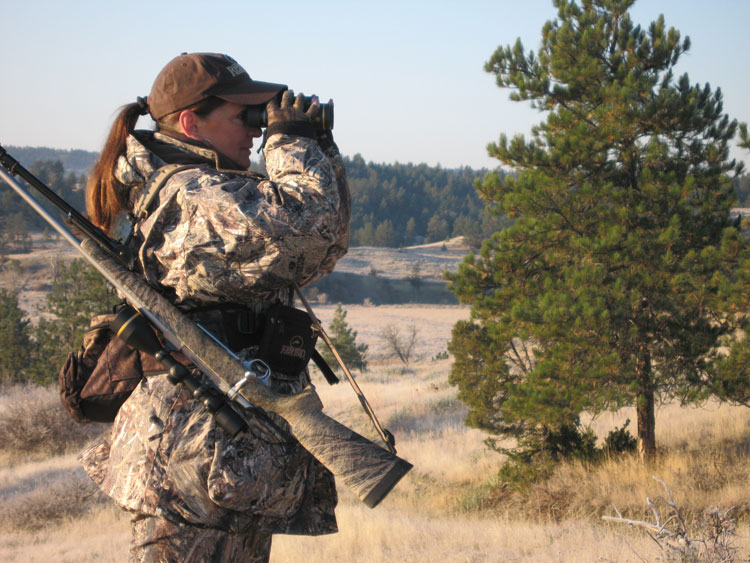
On this hunt, we were filming a late-season hunt north of Gillette, Wyoming. I was hunting with my rifle. Although the weather was extremely cold, there was no snow. The land we were hunting was private land with a lot of gas wells on it. Jerry Martin, another hunter, was also hunting this private land. He went with a ranch hand and two cameramen to hunt for a really big buck that the ranch hand had seen.
I had brought two cameramen with me. I took them and a guide with me to another part of the ranch. One of my cameramen was not a hunter. He had been a news cameraman for a TV station in Missouri and he had filmed news stories for most of his career. The other cameraman was my husband Barney. Our guide was a young boy about 15 or 16 years old. But because he had grown up on the land, he knew all the ranch roads and high points where we could look for mule deer. We would stop every now and then, get out of the truck and go to high points and look for mule-deer bucks. As soon as I got out of the truck the first time, I realized I had gotten into something that I had never seen before – bad, sticky, thick mud. The dirt had thawed a little bit that day in the little protected places that we were walking through, and it had become sticky mud. Although I have hunted in mud in Alabama, Mississippi and Louisiana, this mud in Wyoming was nothing like the mud I’d ever hunted in before.
About two hours before dark, the ranch hand said he saw a really big buck on the horizon several miles away. He asked, “Do y’all want to go after him? He's a really good buck.” We had seen some bucks that morning, but they weren’t big enough to make you want to pick up your binoculars and check them out. So, I said, “Let’s go.”
We had gotten a phone call at noon from Jerry Martin. He said, “I've taken my buck. What’s taking you so long?” They were all laughing, eating and having a good time, while we were trudging through the mud, trying to find a buck to go after. We knew we couldn’t drive to the spot where this young man said he saw, “That really good buck.” I was beginning to wonder if this young fellow really had seen a shooter buck, or if he just wanted to be on a TV show. We didn’t have any other options. So, we decided to go after the deer that our guide said he saw.
On this hunt, I was shooting a .25-06 rifle. I chose that gun because I wanted a flat-shooting, long-range rifle. We took off after this buck, knowing that if we couldn’t get to that buck before dark, we’d have to come back to the truck in the dark with the deer. We’d go down one mountain, walk across a valley and walk up another mountain, hoping we’d see the deer. Every step we took I kept getting taller and taller as that gumbo-type mud kept building-up on my boots. The mud would get 4-5 inches thick, and I could hardly pick up my feet. I’d stumble and fall down, and I’d look for a stick to get the mud off my boots so I could keep on going. When we came to some rocks, I’d slip, slide and fall down because of the mud on my boots, and my cameramen weren’t doing much better.
Another problem was this young man who was guiding us must have had legs 18 feet long. He was tall and skinny, and he was out striding us with those long legs. I told him, “Listen, we can’t keep up with you, because you're not carrying anything but binoculars, and we have rifles and camera gear. Go to the next mountain, and look for the buck, and we’ll catch up to you. I know we’re going to have to race to get to the buck before dark.”
Using this system required two hours to reach a spot where we could even see a deer. Finally, on the last ridge, when we caught up to the guide, he was on his belly in the sage. He motioned to us to come to where he was and stay down low, so we wouldn’t be silhouetted on the crest of the hill. When I reached the guide he whispered, “There’s five bucks, and they’re all feeding in the sage down in the valley. One of those bucks is a real trophy.”
Although the bucks were moving in and out of thick brush, my cameramen were able to get the cameras rolling. I saw the big mule-deer buck with lots of sticker points and all kinds of brush in his rack. I could tell he was a really nice buck. I whispered to the cameraman who had been filming car wrecks and houses burning for the TV station, “Are you ready?” He whispered back, “Yes, this is really great.”
He was excited and was ready for me to take the shot. Barney had his camera on my trigger finger, and the TV guy had his camera on the buck. Even though the sun was going down, I was thinking all the hard work we've put in was about to pay off.
We reached the spot where I could take the shot just before we lost the light we needed to film the hunt. I told the cameramen, “Okay, I'm going to shoot,” and I did. The mule deer made a big jump and went down in the brush, but we couldn’t see him. I was pretty sure I had hit that buck. My TV cameraman said, “I don’t think you hit him. I'm still on him.” He insisted, “I'm still on the buck.” I said, “What buck is that?” Then I realized he was filming a completely different mule-deer buck from the deer I had shot. He never saw the buck I had shot. When I realized what had happened, my TV cameraman was feeling very sheepish and very dejected, and I was trying to console him without biting my tongue.
I knew this was a long shot of about 300 yards. So, we packed up all our stuff. Before we went down in the valley, I said, “We've got to have a reference point that we can see in low light.” We left the young, tall guide up on the hill with everything we didn’t need, wearing a large, silk, orange scarf. I said, “You stay here and wave that orange scarf over your head. Darkness is about to fall, and we need to know how to get back up to the top of this hill. You'll be our reference point.”
The sage was so high that all we could see were tunnels through the sage where the mule deer had walked. The guide on the hill would hand signal us where he thought the deer should be. Finally, we found blood and followed it only a short distance, before we found the buck. When we located the deer, we knew we had to make a long haul to get that deer to a road. But luckily when night fell, Jerry Martin and his crew got in trucks and started driving ranch roads to look for us. Finally, we saw headlights and got to a road where we could wave them down. They carried us back to our vehicle. We drove as close as we could to the buck. Luckily the ground had frozen, and we drug the buck much easier over the frozen ground than we would have been able to drag him in the mud.
We returned to the ranch and saw the big buck Jerry and his crew had taken. But our mule-deer buck was bigger - the biggest deer ever taken on the ranch. The ranch hands didn’t have any clue from where this buck had come. We took a lot of pictures and put a TV show together, even though the TV cameraman had filmed the wrong deer.
Brenda Valentine Has a Montana Mule Deer Hunt in the Middle of the 9/11 Disaster
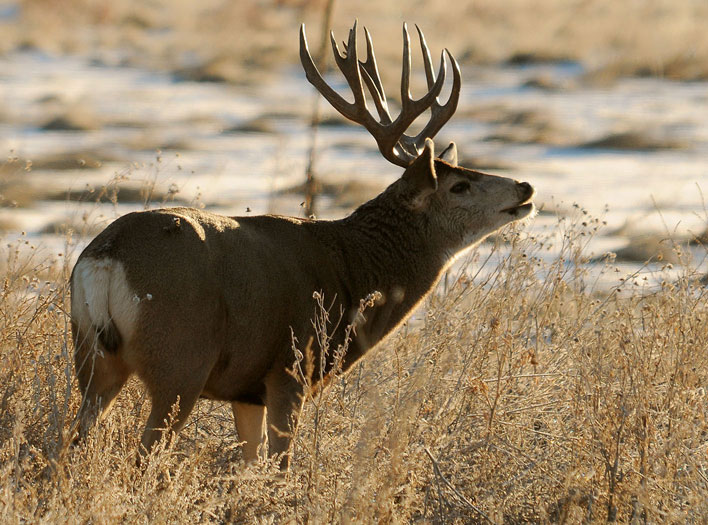
In 2001, along with my cameraman, I was in Idaho hunting antelope. That year, I also had drawn a tag to take a late-season mule deer in Montana. I took my antelope on September 11, 2001. We were staying in an old ranch house. We didn’t have a phone in the ranch house, and we didn’t have cell phone service. So, we weren’t aware of the fact that the World Trade Center and the Pentagon had been attacked, and that a third plane had crashed, while headed toward Washington D.C.
After I took my antelope, we stopped at a little creek to make pictures, and a man on a tractor came by. He stopped, pulled over and said, “Folks, have you heard that two airplanes crashed into the World Trade Center, another plane crashed into the Pentagon, and a third plane on the way to Washington D.C. crashed in a field?” I said, “Who in the world would try to blow up the World Trade Center?” After he told us some sketchy details, we jumped back into our rental car and turned on the radio. Instead of stopping at the ranch house, we went back into town. I got on a land line, called home and learned what was happening.
My cameraman and I were supposed to fly home the next day. But of course, all airports were closed, and we realized we were stuck. So, I called a friend of mine in Montana. I told him where we were, and I told him I knew we weren’t going to be able to get home for a long time. I explained that I had a late-season mule-deer tag and that we had enough gas in the rental car to get to Montana. I asked him, “Is there any way I can use my late-season tag and come out to hunt in Montana this month?” The outfitter said, “Yes. You are booked to come out here in November, but the people who were booked to hunt with me the next two weeks can’t get here because of all the airplanes crashing. Maybe they can come later, and you can take your hunt now.” He checked with the game warden to make sure that we could make that swap.
So, my cameraman and I headed to Montana for an archery hunt. I had my bow with me. When we got to Montana and got squared away, we started out on horseback looking for mule-deer bucks. We’d leave at 3 a.m. from down in the valley and ride up into the mountains where we wanted to glass before daylight. Our plan was to try and see the mule deer that had fed in the valley at night and had come back up into the mountains to bed down during daylight. For the first couple of days, we saw plenty of mule deer but none within bow range. Finally, we abandoned that tactic, and we rode the roads and looked for mule deer anywhere we could find them on horseback.
On the way up the mountain, we spotted a small band of mule deer with a nice buck in it that was about 300 yards from where we had been riding up a trail. We stopped and hid the horses where the mule deer couldn’t see them. We asked our guide to hold the horses, while my cameraman and I tried to stalk in close enough to take the big mule-deer buck that we had seen with the herd. I took my bow and began the stalk with my cameraman close behind me. When we got within about 30 yards, I knew this was as close as we could get. I told my cameraman, “Get ready. I’m going to take the shot.” When the cameraman was ready, I rose up and let the arrow fly. The arrow flew true, and the buck only went a little way before he went down. I told the cameraman to stay with the mule deer and the camera gear, and I’d go back and get the horses.
I was riding a buckskin mare that had a lariat rope on the saddle. I put the lariat around the mule deer’s antlers, tied the other end of the rope to the saddle horn and drug the buck back to the road where we could get to him with the truck. We rode back down off the mountain, got the truck, went back up and loaded up the buck.
On this hunt, we got two TV shows. From that hunt I learned, when you go out West, you always need to have some type of backup plan if weather or some other disaster occurs that can prevent you from getting home. That way, whether you have to use your disaster plan or not, you don’t lose the days that you’ve had scheduled to hunt.



























